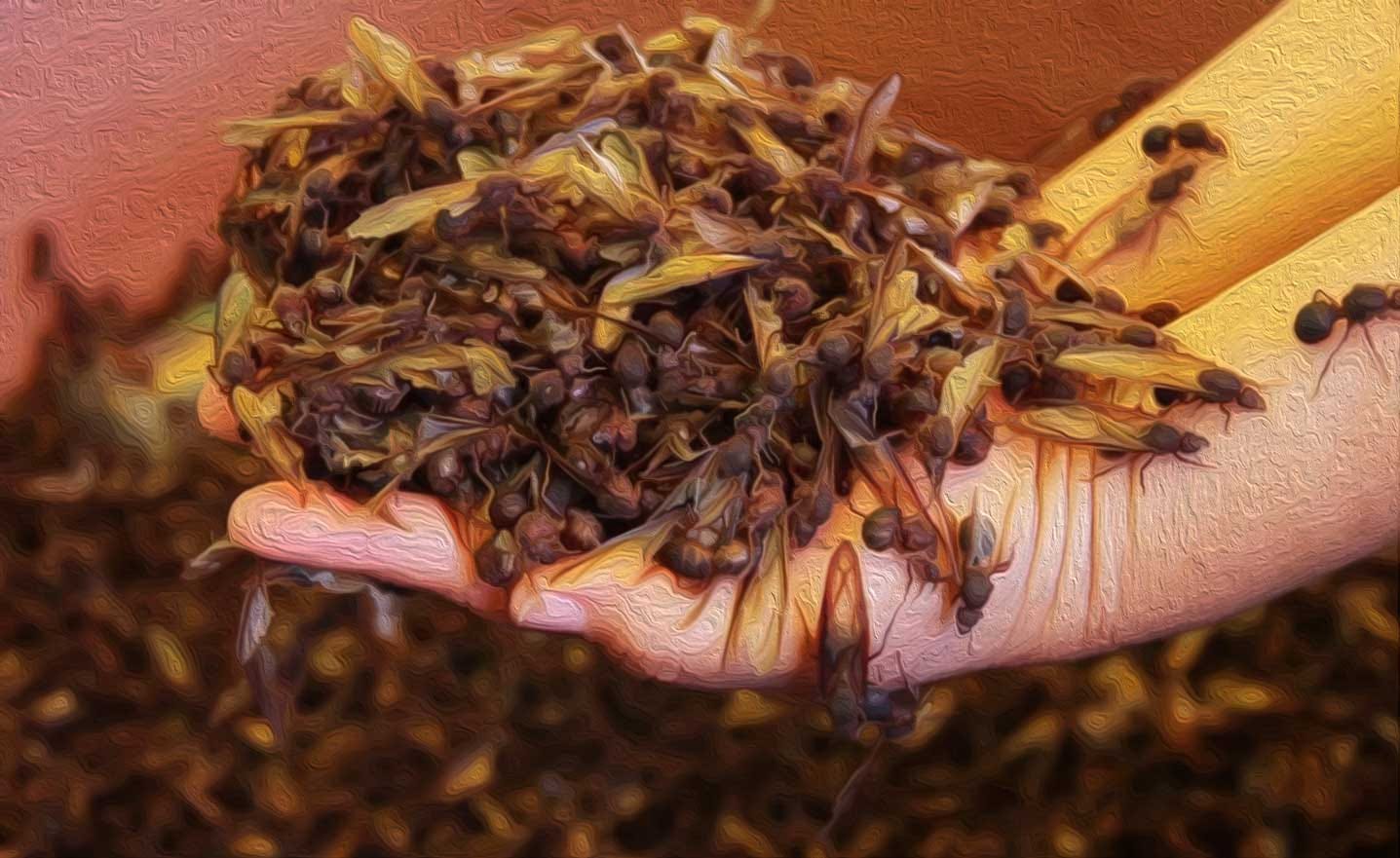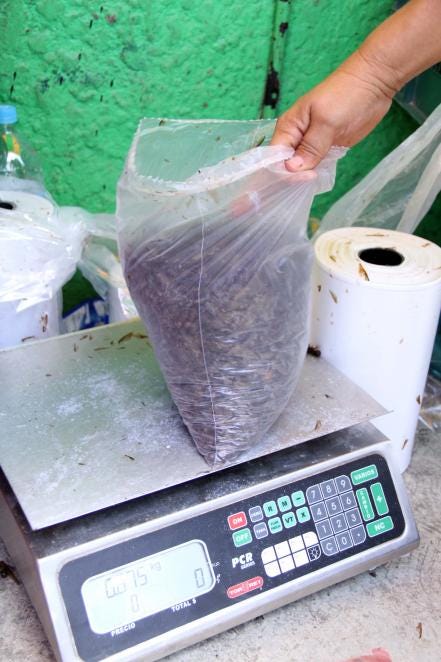The Great Pause Week 52: Climate Fatigue
"“People want to eat the same thing and that’s sort of a condition of humans, but also you want to innovate so you don’t get bored, and that’s life. That’s cooking.”"
No sooner had I finished working up a recipe with my sister to accompany the story last week about grasshopper delicacies, than a Spanish friend said, well, if you like Mexican insects, you have to try chicatanes.
A chicatane is a flying leaf-cutter ant — actually the ant queen — found in many parts of Central America. She evacuates her ground nest at the start of the rainy season lest she drown. Although you might find chicatanes in the farmers’ markets of Puebla, Chiapas, Veracruz, or Hidalgo from June through August, they are most sought after in the state of Oaxaca, where they sell for up to a thousand pesos a kilogram, about $20 per pound.
By carefully watching the patterns of the nest, fearless ant-hunters know when the moment of the queens’ flight is coming. Whole families of men, women and children rise at midnight, don heavy gloves, boots and headlamps, and trek up the mountains to the anthills to wait out the exodus, sometimes until 4 or 5 in the morning.
When the ants begin to emerge, the gatherers rush forward to bag them. Those who cannot afford rubber boots may have brought buckets of water to stick their feet into while they bend over to gather. A bite that is strong enough to sever the leaf of a tropical tree is not something you will quickly forget, and less so scores of such bites all at once.
While I have yet to find chicatanes in the MasterClass recipes of Gabriela Cámera, they are still prepared in the traditional way in Oaxaca. The cooks remove the wings from the queens and place them on the comal, a flat cooking sheet on an open flame, and add a pinch of salt. Once toasted, they are removed and ground with herbs in a metate or molcajete, a stone mortar and pestle. Moistened with broth they are simmered in a saucepan or pot to a thick paste before being spread onto handmade tortillas fresh off the comal and garnished with minced chiles and requesón, panela, or queso Oaxaca.
The paste can also be combined into mole with chicken, armadillo or deer meat, or folded into masa, wrapped in banana leaves, and steamed in clay pots to make chicatane tamales.Mexicans sell chicatanes from their homes or in the markets, as they have since before the arrival of Hernán Cortez, but some will be kept for eating throughout the year. No respectable pantry is without a jar of flying ants.
One month after Mexican cuisine was declared by UNESCO an Intangible Cultural Heritage of Humanity, I attended the gala opening dinner for the 2010 UN climate conference in Cancún. The spirits of the thousand or more delegates had been battered by the debacle the year before in Copenhagen, when an effort led by the United States and other oil exporting nations thwarted the progress of 150 countries, forged by the European Union, China, the island nations, and South Africa. Five years later these same delegates would agree to a climate treaty in Paris, but for now, in Cancún, what was needed was a sense that humanity was even worth saving. México delivered.
From around the nation, the Mexican president and the chairman of the COP pulled together some of the finest chefs, who set forth long tables of Mexico’s most treasured delicacies, prepared to perfection. Mariachis struck up a lively tune, toasts were made, and everyone feasted.
This memory causes me to reflect on the pandemic of this past year and lessons that are largely overlooked now, but which will bear important fruit when we take on the larger, existential, global crisis in our future.
Some of those lessons are boredom, ennui, resignation, and impulsive action borne of false certainty.
On February 26, 2021, the Washington Post ran a story by a Pulitzer Prize winning reporter that described growing optimism in the US medical community. Cases, hospitalizations and deaths had fallen steeply in previous weeks, not just in the United States, where 15% of the population had received at least the first stage vaccination, but worldwide, where vaccines were often unavailable at any cost. The World Health Organization reported an 11 percent global decline in cases and a 20 percent drop in deaths in the final weeks of February.
Experts who believe that summer could be much improved remain cautious about the near term, with highly transmissible variants circulating that could cause a spring spike in cases and with pandemic-weary Americans tiring of restrictions. Continuing to be careful for just a little longer as more people get vaccinated could help ensure people get the summer they want, experts said.
“It’s clear there isn’t going to be some on-off switch where we wake up and the virus is gone,” said Angela Rasmussen, a virologist at Georgetown University. “How it all turns out depends a lot on the virus’s behavior but also on us humans and what we choose to do.”***Rasmussen said public officials urgently need to convey that message of hope so that Americans reeling from a long winter will continue to wear masks and distance this spring and buy time for the rapid increase of vaccinations. Only then will the glorious summer many are imagining become a reality.
“Everybody’s burned out and exhausted. They’re hitting their mental breaking points,” Rasmussen said. “But we’re in the last stretch of this terrible marathon, and people need hope so they’ll be able to make that last dash to the finish line.”
I have a real problem with this messaging. I hope we don’t repeat this when we are deep into reversing climate change and need to dig still deeper for stamina and willpower.
Sadly, it has been like this since the early days of the outbreak. Words like “message of hope,” and “dash to the finish line” are juxtaposed with “reeling from a long winter,” “burned out and exhausted,” “mental breaking points,” and “terrible marathon.” Despite being told by virologists and epidemiologists that this is not how it works, most of the population has been conditioned to the on-off metaphor. There is “normal” and there is “crisis.” After the crisis has been dealt with, we will get back to normal, right? When someone speaks a harder truth, as Anthony Fauci and Bill Gates have, their advice is discounted. The truth is that this crisis is not close to over, and there are even bigger ones coming.
Instead of being prepared for normalcy, we should all be preparing for an even greater readjustment from our lives previously lived.
Instead of being prepared for normalcy, we should all be preparing for an even greater readjustment from our lives previously lived. In the early days of the Covid, I described the hammer and the dance, a paired metaphor put forward by Tomas Puelho. The concept was elegantly simple, and endures. It was what spared New Zealand the ravages experienced in Europe, the UK, the US, and Brazil. When outbreaks happen, you put down the hammer — lockdown quarantines, distancing, mask mandates, contact tracing. As soon as the numbers get better, and you have traced down the origins of the outbreak and have it contained, you can reopen in stages — the dance. Each stage is a test. Overstep and you find yourself back in hammer mode. Step carefully and you can step farther.
What happens when countries or states hammer when they should dance is that people get mad and act in foolish ways. What happens when places dance when they should hammer is that the virus gets worse, hospitals are overwhelmed, caregivers die, and no amount of more dancing will get you out of it. Your only choice is a heavy hammer. Consider how this applies to our climate predicament.
In Cancún, over sweet melons sliced like floral arrangements, the leaders leveled with the delegates. Copenhagen had failed. There was no pretty way to put that. More importantly, the UN’s long tradition of multiculturalism and fair dealing had been undermined by a cabal of the powerful, self-interested wealthy. None of the elected officials were going to put it quite that way but we all knew that was what they meant. Everyone understood we had been rolled. More importantly, nobody wanted to have it happen again. And so began the process that took us to the Paris Agreement, with its 5-year stocktake ritual and putting science in the driver’s seat. A hammer approach. That, in turn, has led from abstract goals like 350 parts per million or 1.5 degrees of warming, to more demanding audits like net-zero by such and such a date. With a void in leadership from the Clinton, Tillerson and Pompeo State Departments, all of whom favored prolonging the dance, unexpected players like transnational corporations and local governments stepped in and forced the hammer approach.
However, when it comes to changing your lifestyle from one that puts 16 tons of carbon into the atmosphere each year to one that takes 16 tons out, the psychological stamina required for a two-week quarantine after travel is child’s play. Wearing a mask to the super-market, getting a temperature scan, and keeping a 6-foot distance in the checkout line is nothing compared to relocating from coastal cities — or offering refuge to migrant islanders —or changing your family’s diet from one that traces centuries of traditions. Those are hammers from Hell.
Gabriela Camara says, “People want to eat the same thing and that’s sort of a condition of humans, but also you want to innovate so you don’t get bored, and that’s life. That’s cooking.”
What we can learn from the pandemic is that remodeling your home, starting a garden, learning a new language, losing some of that excess body fat, and getting really healthy is a good thing to be doing. Now, let’s do that for our planet.
_________________________
The COVID-19 pandemic has destroyed lives, livelihoods, and economies. But it has not slowed down climate change, which presents an existential threat to all life, humans included. The warnings could not be stronger: temperatures and fires are breaking records, greenhouse gas levels keep climbing, sea level is rising, and natural disasters are upsizing.As the world confronts the pandemic and emerges into recovery, there is growing recognition that the recovery must be a pathway to a new carbon economy, one that goes beyond zero emissions and runs the industrial carbon cycle backwards — taking CO2 from the atmosphere and ocean, turning it into coal and oil, and burying it in the ground. The triple bottom line of this new economy is antifragility, regeneration, and resilience.
Help me get my blog posted every week. All Patreon donations and Blogger subscriptions are needed and welcomed. You are how we make this happen. Your contributions are being made to Global Village Institute, a tax-deductible 501(c)(3) charity. PowerUp! donors on Patreon get an autographed book off each first press run. Please help if you can.
#RestorationGeneration
“There are the good tipping points, the tipping points in public consciousness when it comes to addressing this crisis, and I think we are very close to that.”
— Climate Scientist Michael Mann, January 13, 2021.





Comments
I agree that this might be technically possible, but the scale required is stupendous.
Every atom of carbon burned produces a molecule of CO2 that is 3.7 times heavier than the carbon. Since coal is almost pure carbon, for every ton of coal that has been burned in that last 300 years 3.7 tons of CO2 need to be removed from the atmosphere and sequestered. If we use trees to do the removal, and since tree wood is about half carbon, over seven tons of trees need to be grown, transported, processed and buried in the ground.
Even if we took the next 300 years to do it, an industry seven times the size of the coal industry needs to be created. But since we don't have that long, we must create an industry seventy times as large as the current coal industry in order to get all that burned coal removed in the next three decades or so.
Now imagine adding the effort required by the carbon (albeit a lesser percentage carbon than coal) burned from oil, gas, wood, and soil carbon oxidation. All that removal infrastructure also needs to be created without causing a final gigantic pulse of carbon dioxide into the atmosphere. Since our primary energy supply is still 85% fossil fuels, I wonder where the non-carbon energy is going to come from to create this gigantic new carbon removal infrastructure?